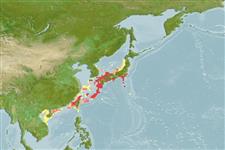Classification / Names
ชื่อสามัญ | ชื่อพ้อง | Catalog of Fishes(สกุล, ชนิด) | ITIS | CoL | WoRMS | Cloffa
>
Gobiiformes (Gobies) >
Gobiidae (Gobies) > Gobiinae
Etymology: Eviota: No etymology given, suggested by Christopher Scharpt: from Latin 'eu' for 'true' and 'iota' for anything very small, in combination 'truly very small' referring to it as being the smallest vertebrate at the time it has benn described by Jenkins (thus, making the suggestion by Scharpt plausible.; masudai: Named after Hajime Masuda (Ref. 76829).
Environment: milieu / climate zone / depth range / distribution range
นิเวศวิทยา
เกี่ยวกับทะเล,น้ำเค็ม เกี่ยวกับหินโสโครก; ระดับความลึก 2 - 64 m (Ref. 76829). Temperate
Northwest Pacific: Japan, also Ogasawara and Ryukyu Islands.
ขนาด / น้ำหนัก / Age
Maturity: Lm ? range ? - ? cm
Max length : 3.2 cm SL เพศผู้/กระเทย; (Ref. 76829); 2.7 cm SL (female)
Short description
สัณฐานวิทยา | ความยาวต่างๆ
เงี่ยงครีบหลัง (รวม): 6 - 7; ก้านครีบอ่อนที่หาง (รวม): 9-10; เงี่ยงครีบก้น 1; ก้านครีบอ่อนที่ก้น: 9. This species is distinguished by the following characters: D VI-I, 10 (9 in only one paratype); typical males (11 of 14 males) have elongate and filamentous dorsal spines reaching to anterior 4th to 8th soft rays of second dorsal fin; A I, 13; pectoral rays 17-18; including 13-17 branched rays; pelvic rays I, 4, I (fifth ray absent in 2 paratypes), fifth pelvic ray greatly reduced, averaging 14.1% (7.0%-28.0%) of fourth ray length, well developed pelvic-fin membranes extending beyond base of first branch of each pelvic-fin ray; lateral scale rows 23-25; transverse scale rows 6-8; cephalic sensory pore system complete sensu Lachner & Karnella (1980); genital papillae of males non-fimbriate; body light pink; edge of scale pockets reddish brown or brown; forming network on body; a small round bluish black or dark brown blotch on each side of nape just above opercle; 2 short longitudinal reddish brown or brown lines on cheek; the upper running posteriorly from postero-ventral corner of eye to a point midway between eye and posterior end of opercle, the lower line running from corner of mouth to a vertical line through posterior edge of eye; a short longitudinal reddish or dark brown line on anteroventral part of preopercle, just below the lower line on cheek; 2 short longitudinal reddish brown or brown bars or oval blotches on pectoral-fin base; one each on the dorsal and ventral part (Ref. 76829).
Occurs in shallow rocky reefs (Ref. 76829).
Life cycle and mating behavior
วัยเจริญพันธุ์ | การสืบพันธุ์ | การวางไข่ | เซลสืบพันธ์ของเพศเมีย(ไข่) | ความดกของไข่ | ตัวอ่อน
Matsuura, K. and H. Senou, 2006. Eviota masudai, a new gobiid fish (Teleostei: Perciformes) from Japan. Mem. Natl. Sci. Mus. (41):341-349. (Ref. 76829)
IUCN Red List Status (Ref. 130435)
Human uses
ข้อมูลเพิ่มเติม
ชื่อสามัญชื่อพ้องกลไกการเผาผลาญพลังงานผู้ล่าการศึกษาเกี่ยวกับผลกระทบของสารประกอบทางเคมีที่เป็นอันตรายต่อสิ่งมีชีวิต ประชากร และสิ่งแวดล้อมการสืบพันธุ์วัยเจริญพันธุ์การวางไข่การรวมกลุ่มวางไข่ความดกของไข่เซลสืบพันธ์ของเพศเมีย(ไข่)Egg development
Age/SizeการเจริญเติบโตLength-weightLength-lengthLength-frequenciesความยาวต่างๆสัณฐานวิทยาตัวอ่อนพลวัตของสัตว์น้ำวัยอ่อนการทดแทนที่อุดมสมบรูณ์BRUVS
อ้างอิงการเพาะเลี้ยงสัตว์น้ำประวัติการเพาะเลี้ยงสัตว์น้ำสายพันธุ์พันธุศาสตร์ElectrophoresesอัตราพันธุกรรมโรคการแปรรูปNutrientsMass conversion
ผู้ร่วมมือรูปภาพหลายรูปStamps, Coins Misc.เสียงปลามีพิษ เช่น ปลาปักเป้าความเร็วรูปแบบการว่ายน้ำพื้นที่เหงือกOtolithsสมองวิสัยทัศน์
เครื่องมือ
Special reports
Download XML
แหล่งที่มาจากอินเตอร์เน็ต
Estimates based on models
Preferred temperature (Ref.
123201): 17.4 - 25.2, mean 21.3 °C (based on 52 cells).
Phylogenetic diversity index (Ref.
82804): PD
50 = 0.5000 [Uniqueness, from 0.5 = low to 2.0 = high].
Bayesian length-weight: a=0.01023 (0.00477 - 0.02194), b=3.02 (2.84 - 3.20), in cm total length, based on LWR estimates for this (Sub)family-body shape (Ref.
93245).
ระดับชั้นอาหาร (Ref.
69278): 3.1 ±0.3 se; based on size and trophs of closest relatives
ความสามารถในการกลับคืนสู่ปกติ (Ref.
120179): ความสูง, เวลาต่ำสุดที่จะทำให้ประชากรเพิ่มขึ้นเป็น 2 เท่าใช้เวลาน้อยกว่า 15 เดือน (Preliminary K or Fecundity.).
Fishing Vulnerability (Ref.
59153): Low vulnerability (10 of 100).
